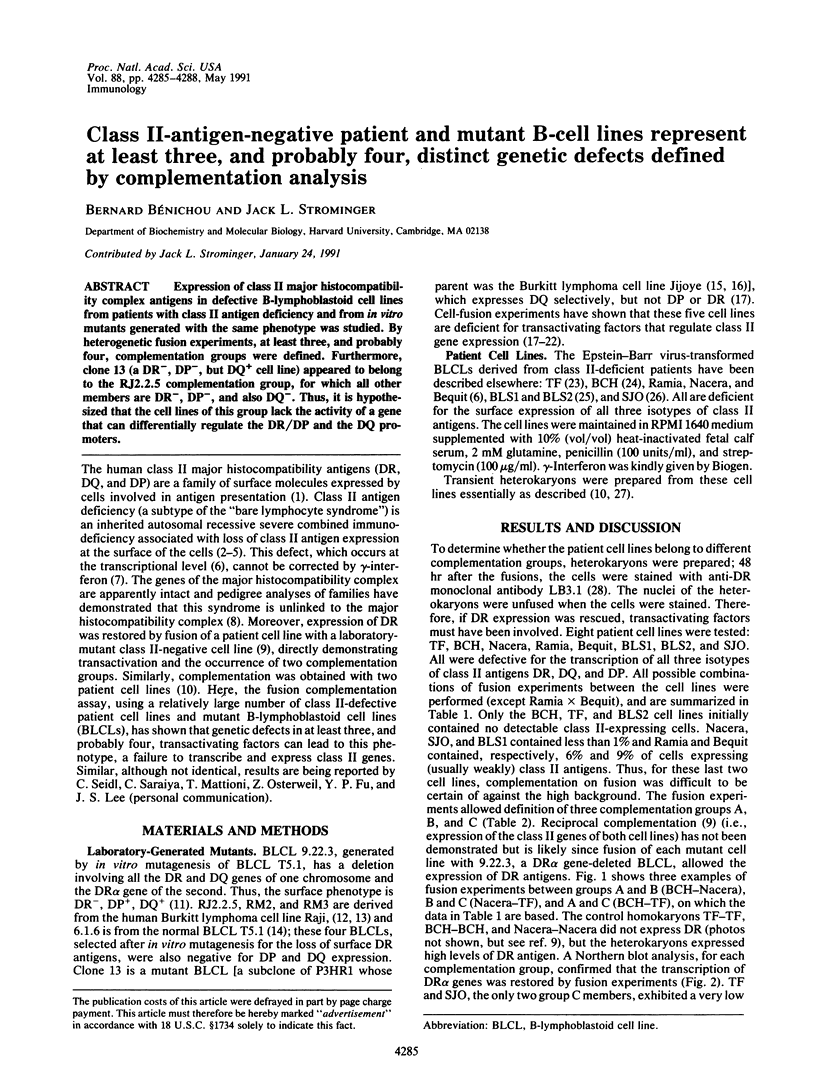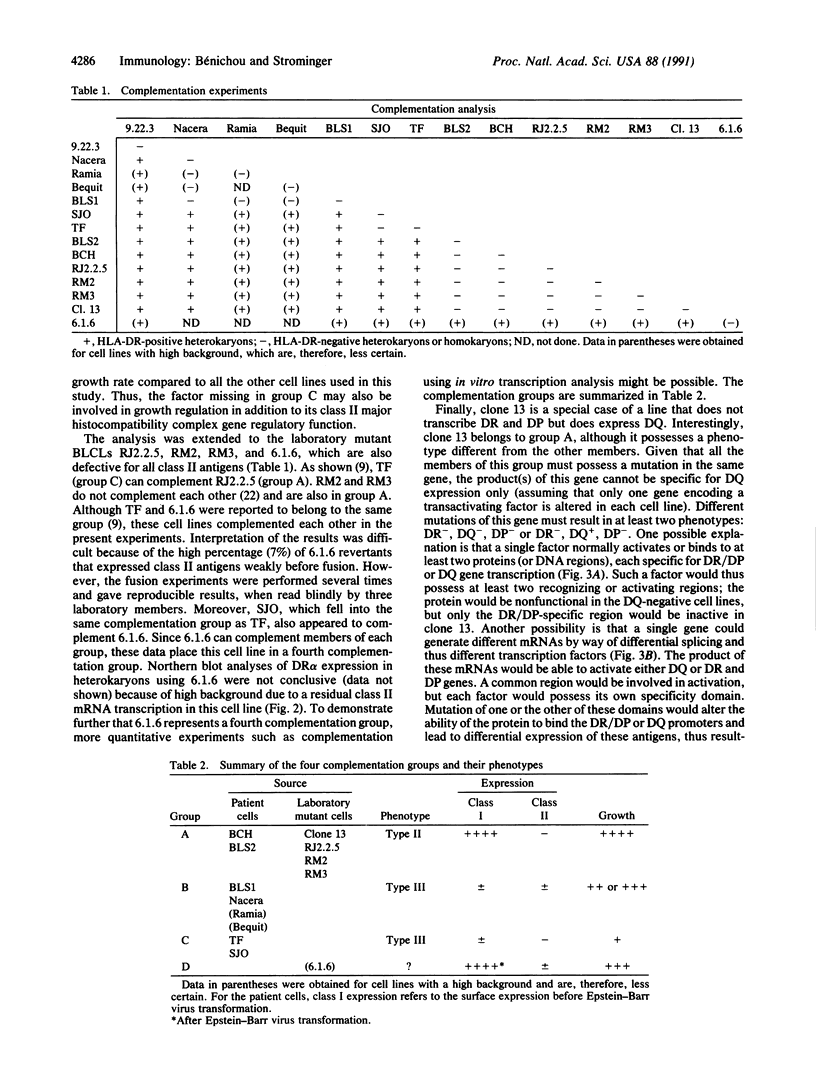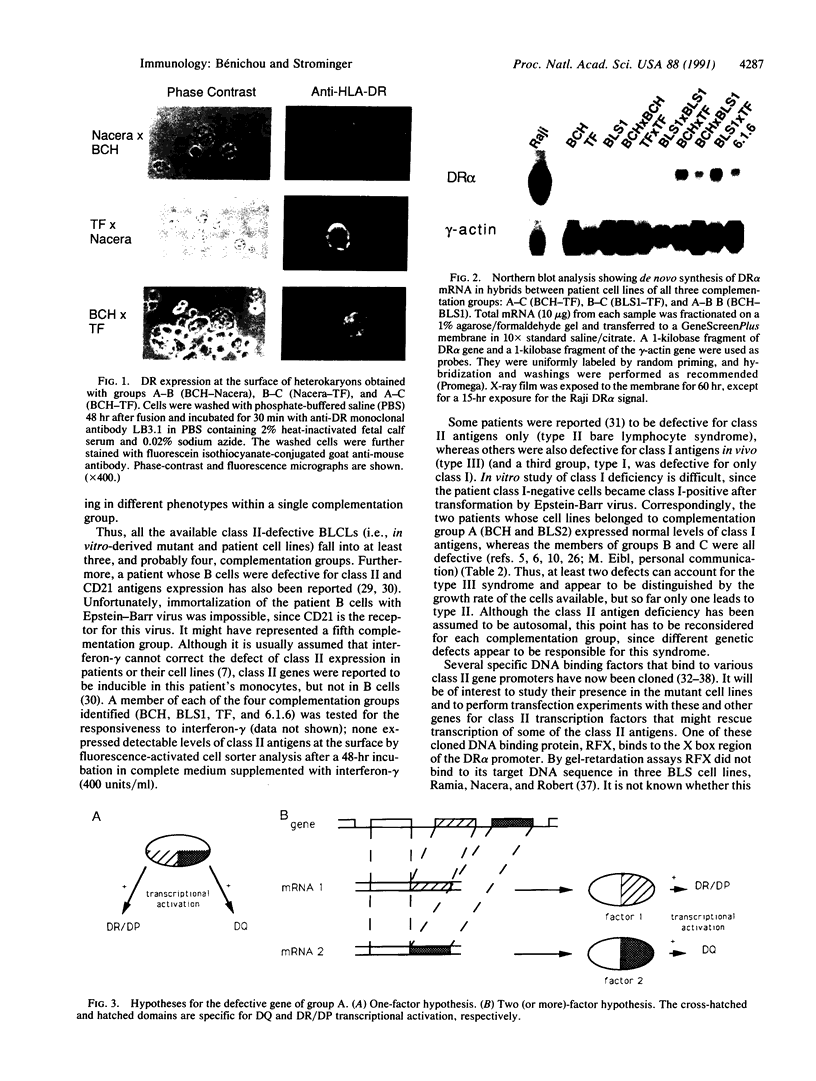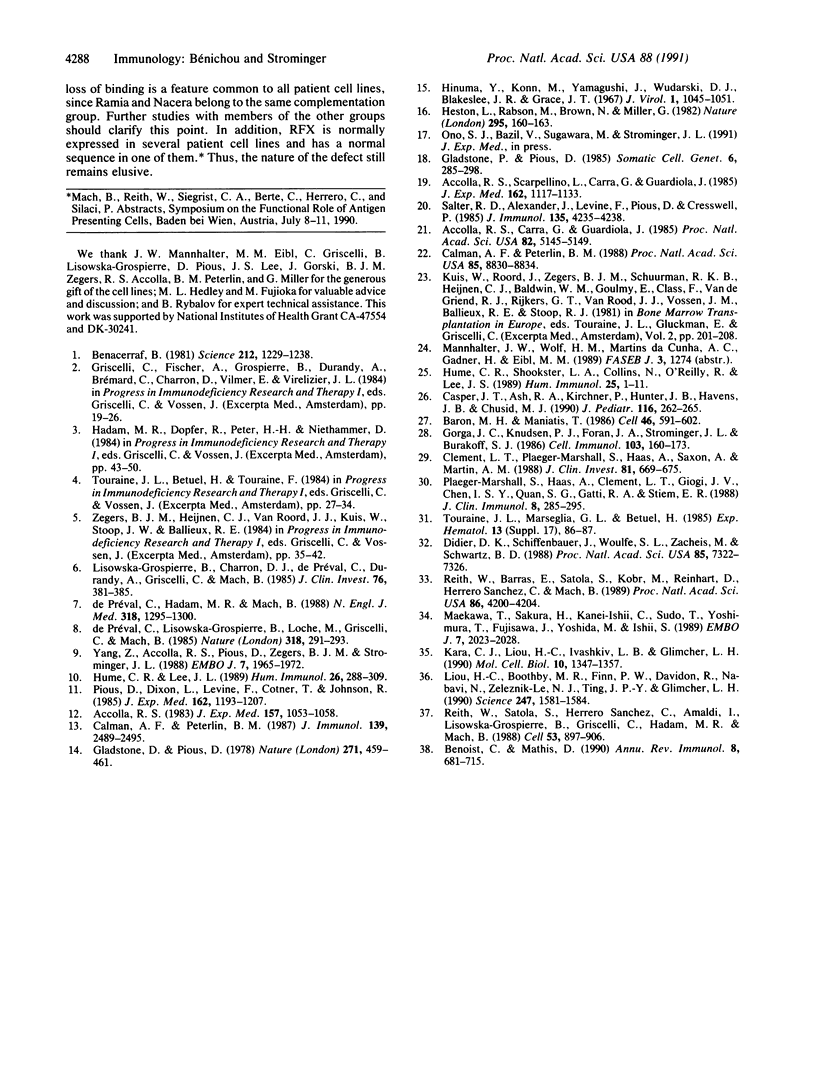Abstract
Expression of class II major histocompatibility complex antigens in defective B-lymphoblastoid cell lines from patients with class II antigen deficiency and from in vitro mutants generated with the same phenotype was studied. By heterogenetic fusion experiments, at least three, and probably four, complementation groups were defined. Furthermore, clone 13 (a DR-, DP-, but DQ+ cell line) appeared to belong to the RJ2.2.5 complementation group, for which all other members are DR-, DP-, and also DQ-. Thus, it is hypothesized that the cell lines of this group lack the activity of a gene that can differentially regulate the DR/DP and the DQ promoters.
Full text
PDF



Images in this article
Selected References
These references are in PubMed. This may not be the complete list of references from this article.
- Accolla R. S., Carra G., Guardiola J. Reactivation by a trans-acting factor of human major histocompatibility complex Ia gene expression in interspecies hybrids between an Ia-negative human B-cell variant and an Ia-positive mouse B-cell lymphoma. Proc Natl Acad Sci U S A. 1985 Aug;82(15):5145–5149. doi: 10.1073/pnas.82.15.5145. [DOI] [PMC free article] [PubMed] [Google Scholar]
- Accolla R. S. Human B cell variants immunoselected against a single Ia antigen subset have lost expression of several Ia antigen subsets. J Exp Med. 1983 Mar 1;157(3):1053–1058. doi: 10.1084/jem.157.3.1053. [DOI] [PMC free article] [PubMed] [Google Scholar]
- Accolla R. S., Scarpellino L., Carra G., Guardiola J. Trans-acting element(s) operating across species barriers positively regulate expression of major histocompatibility complex class II genes. J Exp Med. 1985 Oct 1;162(4):1117–1133. doi: 10.1084/jem.162.4.1117. [DOI] [PMC free article] [PubMed] [Google Scholar]
- Baron M. H., Maniatis T. Rapid reprogramming of globin gene expression in transient heterokaryons. Cell. 1986 Aug 15;46(4):591–602. doi: 10.1016/0092-8674(86)90885-8. [DOI] [PubMed] [Google Scholar]
- Benacerraf B. Role of MHC gene products in immune regulation. Science. 1981 Jun 12;212(4500):1229–1238. doi: 10.1126/science.6165083. [DOI] [PubMed] [Google Scholar]
- Benoist C., Mathis D. Regulation of major histocompatibility complex class-II genes: X, Y and other letters of the alphabet. Annu Rev Immunol. 1990;8:681–715. doi: 10.1146/annurev.iy.08.040190.003341. [DOI] [PubMed] [Google Scholar]
- Calman A. F., Peterlin B. M. Evidence for a trans-acting factor that regulates the transcription of class II major histocompatibility complex genes: genetic and functional analysis. Proc Natl Acad Sci U S A. 1988 Dec;85(23):8830–8834. doi: 10.1073/pnas.85.23.8830. [DOI] [PMC free article] [PubMed] [Google Scholar]
- Calman A. F., Peterlin B. M. Mutant human B cell lines deficient in class II major histocompatibility complex transcription. J Immunol. 1987 Oct 1;139(7):2489–2495. [PubMed] [Google Scholar]
- Casper J. T., Ash R. A., Kirchner P., Hunter J. B., Havens P. L., Chusid M. J. Successful treatment with an unrelated-donor bone marrow transplant in an HLA-deficient patient with severe combined immune deficiency ("bare lymphocyte syndrome"). J Pediatr. 1990 Feb;116(2):262–265. doi: 10.1016/s0022-3476(05)82885-9. [DOI] [PubMed] [Google Scholar]
- Clement L. T., Plaeger-Marshall S., Haas A., Saxon A., Martin A. M. Bare lymphocyte syndrome. Consequences of absent class II major histocompatibility antigen expression for B lymphocyte differentiation and function. J Clin Invest. 1988 Mar;81(3):669–675. doi: 10.1172/JCI113371. [DOI] [PMC free article] [PubMed] [Google Scholar]
- Didier D. K., Schiffenbauer J., Woulfe S. L., Zacheis M., Schwartz B. D. Characterization of the cDNA encoding a protein binding to the major histocompatibility complex class II Y box. Proc Natl Acad Sci U S A. 1988 Oct;85(19):7322–7326. doi: 10.1073/pnas.85.19.7322. [DOI] [PMC free article] [PubMed] [Google Scholar]
- Gladstone P., Pious D. Identification of a trans-acting function regulation HLA-DR expression in a DR-negative B cell variant. Somatic Cell Genet. 1980 Mar;6(2):285–298. doi: 10.1007/BF01538802. [DOI] [PubMed] [Google Scholar]
- Gladstone, Pious D. Stable variants affecting B cell alloantigens in human lymphoid cells. Nature. 1978 Feb 2;271(5644):459–461. doi: 10.1038/271459a0. [DOI] [PubMed] [Google Scholar]
- Gorga J. C., Knudsen P. J., Foran J. A., Strominger J. L., Burakoff S. J. Immunochemically purified DR antigens in liposomes stimulate xenogeneic cytolytic T cells in secondary in vitro cultures. Cell Immunol. 1986 Nov;103(1):160–173. doi: 10.1016/0008-8749(86)90077-8. [DOI] [PubMed] [Google Scholar]
- Heston L., Rabson M., Brown N., Miller G. New Epstein-Barr virus variants from cellular subclones of P3J-HR-1 Burkitt lymphoma. Nature. 1982 Jan 14;295(5845):160–163. doi: 10.1038/295160a0. [DOI] [PubMed] [Google Scholar]
- Hinuma Y., Konn M., Yamaguchi J., Wudarski D. J., Blakeslee J. R., Jr, Grace J. T., Jr Immunofluorescence and herpes-type virus particles in the P3HR-1 Burkitt lymphoma cell line. J Virol. 1967 Oct;1(5):1045–1051. doi: 10.1128/jvi.1.5.1045-1051.1967. [DOI] [PMC free article] [PubMed] [Google Scholar]
- Hume C. R., Lee J. S. Congenital immunodeficiencies associated with absence of HLA class II antigens on lymphocytes result from distinct mutations in trans-acting factors. Hum Immunol. 1989 Dec;26(4):288–309. doi: 10.1016/0198-8859(89)90007-4. [DOI] [PubMed] [Google Scholar]
- Hume C. R., Shookster L. A., Collins N., O'Reilly R., Lee J. S. Bare lymphocyte syndrome: altered HLA class II expression in B cell lines derived from two patients. Hum Immunol. 1989 May;25(1):1–11. doi: 10.1016/0198-8859(89)90065-7. [DOI] [PubMed] [Google Scholar]
- Kara C. J., Liou H. C., Ivashkiv L. B., Glimcher L. H. A cDNA for a human cyclic AMP response element-binding protein which is distinct from CREB and expressed preferentially in brain. Mol Cell Biol. 1990 Apr;10(4):1347–1357. doi: 10.1128/mcb.10.4.1347. [DOI] [PMC free article] [PubMed] [Google Scholar]
- Liou H. C., Boothby M. R., Finn P. W., Davidon R., Nabavi N., Zeleznik-Le N. J., Ting J. P., Glimcher L. H. A new member of the leucine zipper class of proteins that binds to the HLA DR alpha promoter. Science. 1990 Mar 30;247(4950):1581–1584. doi: 10.1126/science.2321018. [DOI] [PubMed] [Google Scholar]
- Lisowska-Grospierre B., Charron D. J., de Préval C., Durandy A., Griscelli C., Mach B. A defect in the regulation of major histocompatibility complex class II gene expression in human HLA-DR negative lymphocytes from patients with combined immunodeficiency syndrome. J Clin Invest. 1985 Jul;76(1):381–385. doi: 10.1172/JCI111974. [DOI] [PMC free article] [PubMed] [Google Scholar]
- Maekawa T., Sakura H., Kanei-Ishii C., Sudo T., Yoshimura T., Fujisawa J., Yoshida M., Ishii S. Leucine zipper structure of the protein CRE-BP1 binding to the cyclic AMP response element in brain. EMBO J. 1989 Jul;8(7):2023–2028. doi: 10.1002/j.1460-2075.1989.tb03610.x. [DOI] [PMC free article] [PubMed] [Google Scholar]
- Pious D., Dixon L., Levine F., Cotner T., Johnson R. HLA class II regulation and structure. Analysis with HLA-DR3 and HLA-DP point mutants. J Exp Med. 1985 Oct 1;162(4):1193–1207. doi: 10.1084/jem.162.4.1193. [DOI] [PMC free article] [PubMed] [Google Scholar]
- Plaeger-Marshall S., Haas A., Clement L. T., Giorgi J. V., Chen I. S., Quan S. G., Gatti R. A., Stiehm E. R. Interferon-induced expression of class II major histocompatibility antigens in the major histocompatibility complex (MHC) class II deficiency syndrome. J Clin Immunol. 1988 Jul;8(4):285–295. doi: 10.1007/BF00916557. [DOI] [PubMed] [Google Scholar]
- Reith W., Barras E., Satola S., Kobr M., Reinhart D., Sanchez C. H., Mach B. Cloning of the major histocompatibility complex class II promoter binding protein affected in a hereditary defect in class II gene regulation. Proc Natl Acad Sci U S A. 1989 Jun;86(11):4200–4204. doi: 10.1073/pnas.86.11.4200. [DOI] [PMC free article] [PubMed] [Google Scholar]
- Reith W., Satola S., Sanchez C. H., Amaldi I., Lisowska-Grospierre B., Griscelli C., Hadam M. R., Mach B. Congenital immunodeficiency with a regulatory defect in MHC class II gene expression lacks a specific HLA-DR promoter binding protein, RF-X. Cell. 1988 Jun 17;53(6):897–906. doi: 10.1016/s0092-8674(88)90389-3. [DOI] [PubMed] [Google Scholar]
- Salter R. D., Alexander J., Levine F., Pious D., Cresswell P. Evidence for two trans-acting genes regulating HLA class II antigen expression. J Immunol. 1985 Dec;135(6):4235–4238. [PubMed] [Google Scholar]
- Yang Z., Accolla R. S., Pious D., Zegers B. J., Strominger J. L. Two distinct genetic loci regulating class II gene expression are defective in human mutant and patient cell lines. EMBO J. 1988 Jul;7(7):1965–1972. doi: 10.1002/j.1460-2075.1988.tb03034.x. [DOI] [PMC free article] [PubMed] [Google Scholar]
- de Préval C., Hadam M. R., Mach B. Regulation of genes for HLA class II antigens in cell lines from patients with severe combined immunodeficiency. N Engl J Med. 1988 May 19;318(20):1295–1300. doi: 10.1056/NEJM198805193182003. [DOI] [PubMed] [Google Scholar]
- de Préval C., Lisowska-Grospierre B., Loche M., Griscelli C., Mach B. A trans-acting class II regulatory gene unlinked to the MHC controls expression of HLA class II genes. Nature. 1985 Nov 21;318(6043):291–293. doi: 10.1038/318291a0. [DOI] [PubMed] [Google Scholar]






